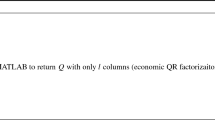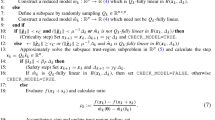Abstract
In frequency and direction of arrival (DOA) tracking problems, singular value decomposition (SVD) can be used to track the signal subspace. Typically, for a problem sizen, only a few, sayr dominant eigencomponents need to be tracked, wherer⋘n. In this paper we show how to modify the Jacobi-type SVD to track only ther-dimensional signal subspace by forcing the (n-r)-dimensional noise subspace to be spherical. Therby, the computational complexity is brought down fromO(n2) toO(nr) per update. In addition to tracking the subspace itself, we demonstrate how to exploit the structure of the Jacobi-type SVD to estimate the signal subspace dimension via a simple adptive threshold comparison technique. Most available computationally efficient subspace tracking algorithms rely on off-line estimation of the signal subspace dimension, which acts as a bottleneck in real-time parallel implementations. The noise averaged Jacobi-type SVD updating algorithm presented in this paper is capable of simultaneously tracking the signal subspace and its dimension, while preserving both the low computational cost ofO(nr) and the parallel structure of the method, as demonstrated in a systolic implementation. Furthermore, the algorithm tracks all signal singular values. Their squares are estimates of the powers in the orthogonal modes of the signal. Thus, applications of the algorithm are not limited to only DOA and frequency tracking where information about the powers of signal components is not exploited.
Similar content being viewed by others
References
V.F. Pisarenko, “The retrieval of harmonics from a covariance function,”Geophys. J. Roy. Astron. Soc., Vol. 33, pp. 347–366, 1973.
R.O. Schmidt, “Multiple emiter location and signal parameter estimation,” inProc. RADC Spectrum Estimation Workshop, pp. 243–258, Oct. 1979.
R.O. Schmidt, “Multiple emiter location and signal parameter estimation,”IEEE Trans. Antenn. Propagat., Vol. AP-34, pp. 276–280, March 1986.
R. Kumaresan and D.W. Tufts, “Estimating the angles of arrival of multiple plane waves,”IEEE Trans. Aerosp. Electron. Syst., Vol. 19, pp. 134–139, 1983.
R. Roy and T. Kailath, “ESPRIT—Estimation of signal parameters via rotational imvariance techniques,”IEEE Trans. ASSP, Vol. 37, 1989.
M. Viberg, B. Ottersten, and T. Kailath, “Detection and estimation in sensor arrays using weighted subspace fitting,“IEEE Trans. Signal Processing, Vol. 39, pp. 2436–2449, 1991.
P. Comon and G.H. Golub, “Tracking a few extreme singular values and vectors,”Proc IEEE, pp. 1327–1343, Aug. 1990.
R.J. Bunch, C.P. Nielsen, and D.C. Sorensen, “Rank-one modification of the symmetric eigenproblem,”Numer. Math, Vol. 31, pp. 31–48, 1979.
N.L. Owsley, “Adaptive data orthogonalization,” inProc. IEEE ICASSP'78, pp. 109–112, 1978.
I. Karasalo, “Estimating the covariance matrix by signal subspace averaging,”IEEE Trans. ASSP, Vol. 34, pp. 8–12, Feb. 1986.
J. Yang and M. Kaveh, “Adaptive eigensubspace algorithms for direction of frequency estimation tracking,”IEEE Trans. ASSP, Vol. 36, pp. 241–251, 1988.
M. Moonen, P. Van Dooren, and J. Vandewalle, “Updating singular value decomposition. A parallel implementation,” inProc. SPIE Advanced Algorithms and Architectures for Signal Processing, San Diego, Aug. 1989, Vol. 1152, pp. 80–91.
R.D. DeGroat, “Noniterative subspace tracking,”IEEE Trans. Signal Processing, Vol. 4, pp. 571–577, March 1992.
G.W. Stewart, “An updating algorithm for subspace tracking,”IEEE Trans. Signal Processing, Vol. 40, pp. 1535–1541, June 1992.
S.Y. Kung,Digital Neural Processing, Englewood Cliffs; Prentice-Hall, 1993.
B. Yang and F. Gersemsky, “An adaptive algorithm of linear computational complexity for both rank and subspace tracking,” inProc. IEEE ICASSP'94, Adelaide, April 1994, pp. IV33–IV36.
B. Yang, “Gradient based subspace tracking algorithms and systolic implementation,”J. of High Speed Electronics and Systems, Vol. 4, pp. 203–218, 1993.
E.M. Dowling, L.P. Amman, and R.D. DeGroat, “A TQR-iteration based adaptive SVD for real time angle and frequency tracking,”IEEE Trans. Signal Processing, Vol. 42, pp. 914–926, April 1994.
E.M. Dowling, R.D. DeGroat, D. A. Linebarger, and H. Ye, “Sphericalized SVD updating for subspae tracking,” inSVD and Signal Processing: Algorithms, Applications and Architectures III, North Holland Publishing Co., 1995.
A. Kavčié and B. Yang, “A new efficient subspace tracking algorithm based on singular value decomposition,” inProceedings IEEE ICASSP'94, Adelaide, April 1994, pp. IV485–IV488.
A. Kavčić and B. Yang, “Simultaneous subspace tracking and rank estimation,” inProc. SPIE Advanced Signal Processing Algorithms, San Diego, July 1995, Vol. 2563, pp. 20–217.
S. Haykin, “Adaptive Filter Theory, Englewood Cliffs: Prentice Hall, 2nd ed., 1991.
K.V. Fernando and S.J. Hammarling, “Systolic array computation of the SVD of complex matrices,” inProc. SPIE Advanced Algorithms and Architectures for Signal Processing, Vol 696, pp. 54–61, 1986.
G.W. Stewart, “A Jacobi-like algorithm for computing the Schur decomposition of a non-Hermitian matrix,” Tech. Report 1321, Computer Science Department, University of Maryland, 1983.
F.T. Luk, “A triangular processor array for computing the singular value decomposition,” Tech. Report 84-625, Department of Computer Science, Cornell University, 1984.
J.-P. Charlier and P. Van Dooren, “A Jacobi-like algorithm for computing the generalized Schur form of a regular pencil,”J. Comp. Appl. Math., Vol. 27, pp. 17–36, 1989.
A. Akaike, “A new look at the statistical model identification,”IEEE Trans. Automatic Control, Vol. 19, pp. 716–723, 1974.
J. Rissanen, “Modelling by shortest data description,”Automatica, Vol. 14, pp. 465–471, 1978.
G. Schwartz, “Estimating the dimension of a model,”Ann. Stat., Vol. 6, pp. 461–464, 1978.
M. Wax and T. Kailath, “Detection of signals by information theoretic criteria,”IEEE Trans. ASSP, Vol. 33, pp. 387–392, 1985.
T.W. Anderson,An Introduction to Multivariate Statistical Analysis, New York: John Wiley and Sons, 2nd ed., 1984.
H.L. Van Trees,Detection, Estimation, and Modulation Theory, New York: John Wiley and Sons, Vol. I, 1968.
M. Moonen,Jacobi-Type Updating Algorithms for Signal Processing, Systems Identification and Control, Ph.D.thesis, Department of Electrical Engineering, Katholike Universiteit Leuven, Heverlee, Belgium, 1990.
E.M. Dowling, R.D. DeGroat, D.A. Linebarger, and Z. Fu, “Real time architecture for sphericalized SVD updating,” inSVD and Signal Processing: Algorithms, Applications and Architectures III, North Holland Publishing Co., 1995.
L.L. Scharf,Statistical Signal Processing, New York: Addison-Wesley Publishing Company, 1991.
Author information
Authors and Affiliations
Rights and permissions
About this article
Cite this article
Kavčić, A., Yang, B. Subspace tracking with adaptive threshold rank estimation. J VLSI Sign Process Syst Sign Image Video Technol 14, 75–91 (1996). https://doi.org/10.1007/BF00925270
Received:
Revised:
Published:
Issue Date:
DOI: https://doi.org/10.1007/BF00925270




